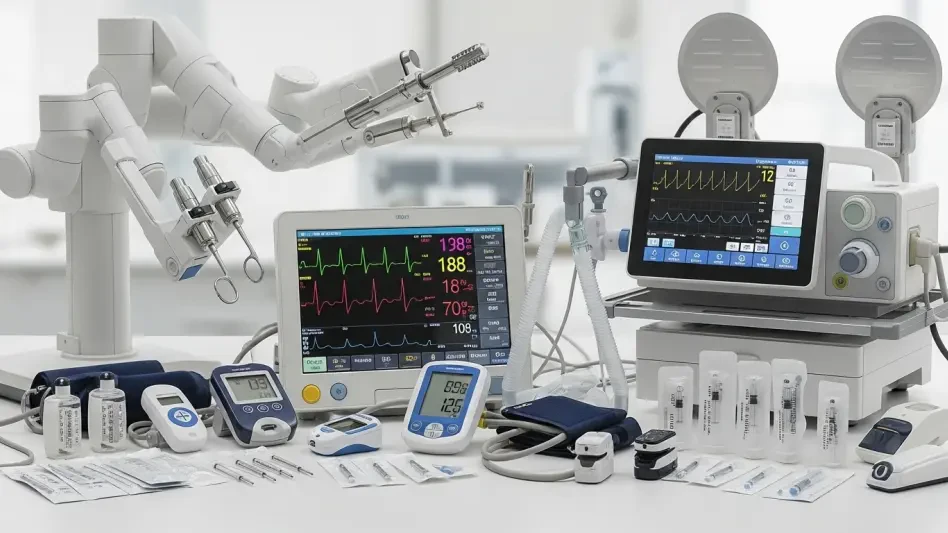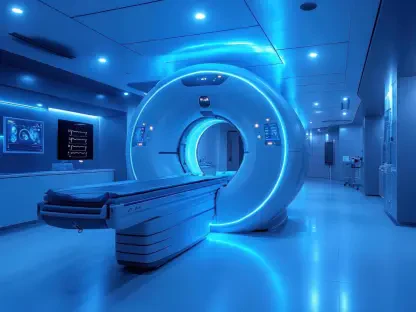Understanding the Medical Device Industry and MDUFA’s Role
The medical device industry stands at a critical juncture, with innovation racing ahead at an unprecedented pace—consider that over 120 novel devices gained approval in a single recent year, a testament to the sector’s dynamism. This industry, encompassing diagnostics, therapeutics, and wearables, serves as a cornerstone of modern healthcare, addressing complex challenges from chronic disease management to real-time health monitoring. Major players, including leading medtech companies and regulatory bodies like the FDA, drive progress while navigating a landscape shaped by both technological breakthroughs and stringent oversight.
At the heart of this regulatory framework lies the Medical Device User Fee Amendments (MDUFA), a mechanism introduced in the early 2000s to fund the FDA’s review processes through fees collected from industry stakeholders. MDUFA ensures that the agency can maintain rigorous evaluation standards while committing to specific timelines, a balance that has transformed the efficiency of device approvals over the years. This system directly influences how quickly and safely new technologies reach patients, making it a pivotal force in the industry’s growth trajectory.
The significance of MDUFA extends beyond mere funding; it shapes the competitive environment for medtech firms by establishing predictable regulatory pathways. As the industry evolves with segments like AI-driven diagnostics gaining prominence, the role of MDUFA in fostering innovation while safeguarding public health becomes even more pronounced. With each iteration, this framework adapts to emerging needs, setting the stage for discussions on how its next version will impact the sector’s future.
Current Trends and Performance in Medical Device Regulation
Emerging Technologies and Regulatory Priorities
Technological advancements are reshaping the medical device sector, with AI and machine learning leading the charge—over 1,250 FDA clearances have been granted for such devices, predominantly in radiology. These innovations promise enhanced diagnostic precision and personalized treatments, pushing the boundaries of what medical technology can achieve. The FDA has responded by prioritizing modernization, integrating digital tools to streamline review processes and ensure that cutting-edge devices reach the market without unnecessary delays.
A key initiative in this modernization effort is the adoption of generative AI tools, such as the FDA’s Elsa project, which assists in organizing vast application data and identifying relevant research. While these tools hold potential to boost efficiency, challenges like data reliability and the need for staff training persist, reflecting a cautious approach to technology integration. The agency’s focus remains on ensuring that such advancements do not compromise the thoroughness of safety evaluations.
Beyond technology, the FDA’s regulatory priorities under MDUFA emphasize timely patient access and global competitiveness. The goal is to position the U.S. as the primary market for novel devices, outpacing international counterparts through a commitment to both speed and quality. This dual focus underscores a broader strategy to support American innovation while maintaining the highest standards of public health protection.
Industry Metrics and Growth Outlook
Data paints a promising picture of the medical device industry’s performance, with a record 120 novel device approvals achieved in a recent year under MDUFA V. This milestone reflects the effectiveness of the current user fee structure in accelerating innovation while upholding rigorous standards. Additionally, user fees are projected to reach $427 million by fiscal year 2026, a significant increase that signals growing industry investment in regulatory processes.
Looking ahead, the transition to MDUFA VI is expected to further influence innovation timelines, potentially shortening review periods for groundbreaking technologies. Market expansion also appears on the horizon, as streamlined regulations could enable smaller firms to bring niche solutions to patients more swiftly. These forecasts highlight the framework’s role in not just sustaining but amplifying industry growth.
The broader outlook suggests that sustained funding and strategic regulatory adjustments under MDUFA VI will be crucial for maintaining this momentum. As the industry grapples with an increasingly complex landscape, the ability to adapt review processes to emerging technologies will likely determine the pace of future advancements. Such metrics and projections offer a glimpse into a sector poised for transformation under evolving oversight.
Challenges in Medical Device Regulation Under MDUFA
The path to effective regulation under MDUFA is not without obstacles, particularly as technology outpaces traditional review mechanisms. One prominent challenge lies in the reliability of AI-driven tools, where issues such as data “hallucination”—generating inaccurate or fabricated information—raise concerns about the integrity of regulatory assessments. Addressing these technological hurdles requires robust validation processes to ensure that innovation does not come at the expense of accuracy.
Staffing shortages and training needs further complicate the regulatory landscape, with past layoffs at the FDA’s Center for Devices and Radiological Health (CDRH) impacting the capacity to handle a growing volume of complex submissions. Rebuilding expertise through targeted hiring and professional development is essential to keep pace with industry advancements. Without adequate human resources, even the best-funded systems risk delays and inefficiencies in device approvals.
Transparency in resource allocation also emerges as a critical issue, with stakeholders seeking clarity on how escalating user fees are utilized to support front-line review teams. Balancing financial investments with operational needs will be vital to maintain trust between the FDA and industry partners. Overcoming these challenges demands a collaborative approach, leveraging both technological solutions and strategic planning to strengthen the regulatory framework.
Regulatory Framework and MDUFA VI Negotiations
MDUFA has evolved through multiple iterations since its inception, each refining the balance between regulatory efficiency and safety standards. The upcoming MDUFA VI, set to guide operations through 2032, represents an opportunity to address contemporary demands while building on past successes. Negotiations for this framework focus on modernization, ensuring that the U.S. retains leadership in global device regulation through adaptive and forward-thinking policies.
Industry input plays a significant role in shaping MDUFA VI, with organizations like the Medical Device Manufacturers Association (MDMA) and AdvaMed advocating for quality over mere speed in reviews. Their perspectives emphasize the importance of thorough evaluations, even if it means longer timelines, to guarantee patient safety. This stance reflects a mature partnership between regulators and stakeholders, prioritizing long-term outcomes over short-term gains.
A central theme of these negotiations is achieving equilibrium among safety, efficacy, and efficiency in compliance standards. The FDA aims to streamline processes without compromising on rigorous oversight, a goal that requires careful calibration of user fee structures and performance metrics. As discussions progress, the outcomes of MDUFA VI will likely set a precedent for how regulatory frameworks can adapt to an ever-changing technological landscape.
Future Directions for Medical Device Innovation with MDUFA VI
Looking toward the horizon, MDUFA VI is poised to influence medical device innovation through its approach to emerging technologies like real-world data integration. This method, which leverages data from actual patient experiences, could transform how devices are evaluated throughout their lifecycle, offering a more dynamic understanding of performance and safety. Such advancements promise to bridge the gap between clinical trials and real-world outcomes.
Global competition presents another dimension of impact, with markets in China and Europe challenging U.S. dominance in medtech innovation. MDUFA VI must therefore support policies that bolster American companies’ ability to compete, ensuring that regulatory speed and quality remain unmatched. Economic factors, including fluctuating investment in healthcare technology, will also shape how this framework influences market disruptors and new entrants.
The FDA’s role in fostering collaboration across the ecosystem—engaging with data scientists, methodologists, and patients—will be critical under MDUFA VI. By adapting to a data-rich environment, the agency can enhance decision-making processes and anticipate future needs. This proactive stance could redefine the trajectory of medical device development, positioning the U.S. as a leader in both innovation and regulatory excellence.
Conclusion and Strategic Outlook for MDUFA VI
Reflecting on the insights gathered, it becomes evident that MDUFA VI stands as a pivotal framework that balances the imperatives of speed and safety in medical device regulation. The discussions around modernization, staffing, and global competitiveness reveal a shared commitment among stakeholders to elevate the industry’s standards. This comprehensive exploration highlights the transformative potential of user fees in sustaining a robust regulatory environment.
Moving forward, actionable steps emerge as essential for capitalizing on these findings. Stakeholders need to prioritize investments in training and technology to address capacity challenges, ensuring that the FDA remains equipped to handle complex submissions. Collaborative platforms involving industry, regulators, and patient advocates also appear crucial to refine real-world data integration, paving the way for more adaptive oversight.
Ultimately, the path ahead demands a strategic focus on transparency and innovation, with MDUFA VI serving as a catalyst for sustained progress. By aligning resources with long-term goals, the medical device sector can navigate global challenges while delivering safe, effective technologies to patients. This outlook underscores the importance of proactive adaptation in shaping a future where regulatory excellence and industry growth go hand in hand.









